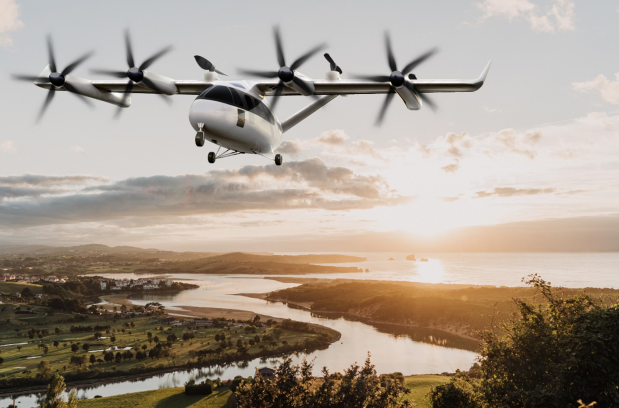
The LimoConnect can carry a pilot and seven passengers up to 150 mi. (241 km).
Montreal-based Limosa has unveiled the design of its LimoConnect V2 crossover electric-vertical/conventional-takeoff-and-landing (eVTOL/eCTOL) aircraft, including several new design changes intended to improve functionality and commercial feasibility.
Unveiled July 22 at the Electric Aircraft Symposium in Oshkosh, Wisconsin, the LimoConnect V2 halves the number of moving parts and tilting mechanisms in the aircraft’s distributed electric propulsion system.
As a result, the new design includes four tilting five-bladed rotors on the wing leading edge and four fixed, two-bladed lift rotors; two on the wing trailing edge and two on the aircraft’s V-tail. The previous iteration had eight five-bladed tilting rotors; four on the wing leading edge and four on the tail.
The redesigned propulsion system means that only the four tilting rotors will be used during cruise, with the fixed rotors only used during vertical flight and hover. All eight rotors were previously used during cruise.
Speaking to the AAM Report, Limosa founder and CEO Hamid Hamidi said that having eight electric motors powering eight tilting rotors in cruise flight on the LimoConnect V1 was inefficient because it meant reducing the rpm of each motor to a nonoptimal level.
“We decided that by using only half the motors in cruise, the rpm is not going to fall under the [optimal] efficiency of the motors,” Hamidi says. “We realized we didn’t actually need all eight motors for cruise and we can use the rear motors just to contribute to hover.”
Another design change involved moving the wing forward by several inches to add more interior space to the cabin, which can carry up to seven passengers or a 500-kg (1,100-lb.) payload. The new wings are also more rectangular and less curved, which Hamidi says further simplifies the design for manufacturing.
The redesigned LimoConnect also features a revamped control surface system with large fowler flaps, which improves its ability to take off conventionally from short runways. And a new avionics suite provides enhanced safety and situational awareness for pilots.
The LimoConnect V2’s design changes were driven by learnings from two subscale prototypes that were built and tested by Limosa–one of which was 1:10 scale and the other 1:8–as well as feedback from Transport Canada, third-party consultancies and dozens of simulations, Hamidi said.
Among a crowded pack of eVTOL startups, Hamidi believes Limosa enjoys several key advantages that make its vehicle stand out. These include a large cabin that can carry seven passengers, more than most eVTOL designs; the ability to take off conventionally, including from short runways; a modular cabin design that can be quickly customized for various applications; and provincial and federal support from the Montreal and Canadian governments.
Limosa is aiming to assemble a full-scale prototype by mid-2024, with flight testing beginning afterward. By late 2024, Hamidi said he expects the startup to receive its G-1 Certification Basis from Transport Canada. Certification and market entry is currently targeted for 2028.





